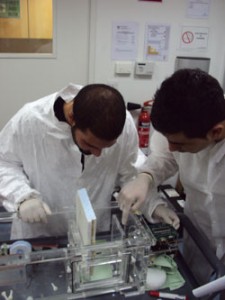Research
 Research work capitalized on resources and Departmental and laboratory infrastructure in three research areas: a) Phantom Validation Experimentation, b) Ex-vivo tissue characterization, and c) Cardiac Biomechanics. Such work and research interests explored the mechanical and functional modeling of the murine and human hearts through the development of new imaging techniques, advanced applications, and processing tools.
Research work capitalized on resources and Departmental and laboratory infrastructure in three research areas: a) Phantom Validation Experimentation, b) Ex-vivo tissue characterization, and c) Cardiac Biomechanics. Such work and research interests explored the mechanical and functional modeling of the murine and human hearts through the development of new imaging techniques, advanced applications, and processing tools.
For the dedicated imaging studies, access to the vital infrastructure of the CIVM at Duke had been established as part of successful international collaborative funding through three projects. The MR imaging systems at the CIVM are unique, using specially designed high-field magnets and gradients interfaced to state-of-the-art clinical imaging consoles. These include a 2T medium bore MR microscope (Oxford 30-cm horizontal bore magnet), GE Excite console, 2 sets of 18 Gauss/cm shielded gradients, 15 cm clear bore with switching speeds of 400mT/m over 120 mm FOV, 1 MHz receivers, and a scan synchronous ventilator system, a 7T medium bore MR microscope (Magnex 21-cm horizontal bore with GE Excite console, 2 sets of 40 Gauss/cm shielded gradients, with gradient switching of 770 mT/m over 90mm), and a 9.4T MR microscope. Four dedicated systems support MR, CT, X-ray and PET reconstruction. Workstations support the visualization and analysis package VGStudio MAX, as well as Amira, Volocity, and Vitrea. A dedicated “analysis engine” supports custom image analysis workflows. Authorized users inside and outside the Center can access project/animal/ scan web applications through a secure proxy server.
Collaborative efforts with the University of Virginia at Charlottsville had allowed expansion of research activities to non-invasive DENSE-mouse MRI.
The α-Evresis Medical Diagnostic Center in Nicosia had also been a local collaborating site since 2010 for phantom and human volunteer studies at 1.5 T.







